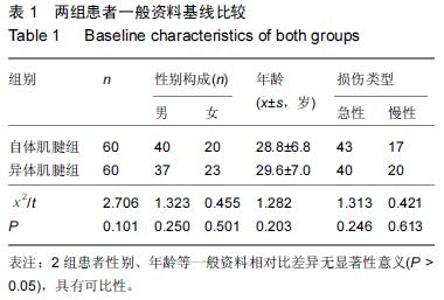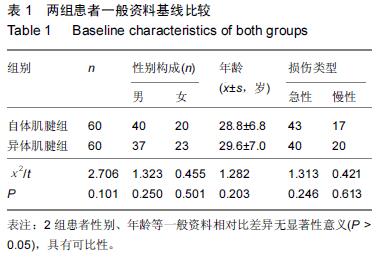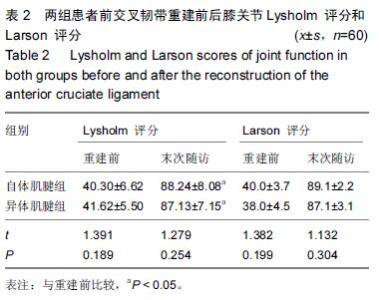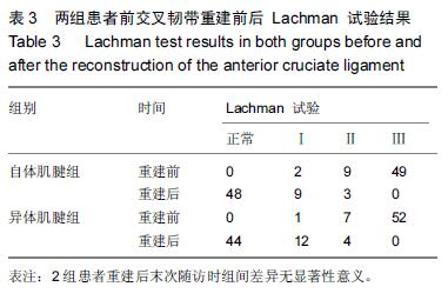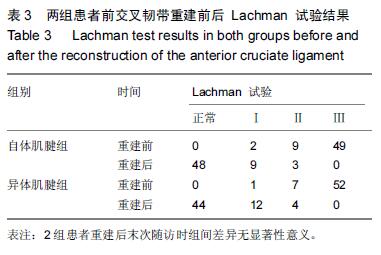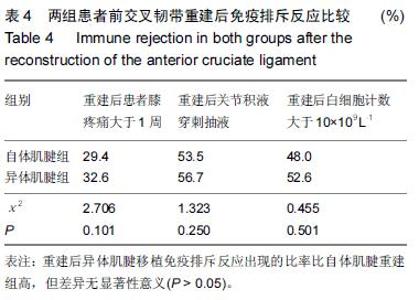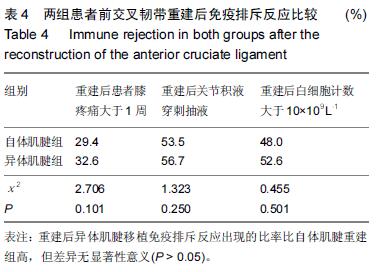[2] 莫成敏,林秋喜.自体腘绳肌腱、同种异体肌腱重建后交叉韧带的疗效比较[J].中国医药导报,2015,12(10): 98-102.
[3] 李卫平,宋斌,杨睿,等.关节镜下膝关节前后交叉韧带重建:自体移植与异体移植的中远期疗效对比[J].中国组织工程研究,2012,16(5):939-943.
[4] 毕海勇,孙秀江,慕宏杰,等.自体及同种异体肌腱重建前交叉韧带的前瞻性比较研究[J].中华外科杂志,2013,51(1): 44-48.
[5] Mehta VM,Mandala C,Foster D,et al.Comparison of revision rates in bone-patella tendon-bone autograft and allograft anterior cruciate ligament reconstruction.Orthopedics.2010;33(1):12-12.
[6] 邓伟捷,郑维蓬,魏合伟,等.关节镜下自体腘绳肌腱重建前交叉韧带术后骨道增宽研究进展[J].医学临床研究, 2015, 33(1):170-172.
[7] 潘乐,李世光,左健,等.同种异体肌腱移植修复运动损伤:免疫排斥反应及降低免疫排斥反应的方法[J].中国组织工程研究与临床康复,2011,15(53):10043-10046.
[8] Mook WR, Parekh SG, Nunley JA.Allograft reconstruction of peroneal tendons: Operative technique and clinical outcomes.Foot Ankle Int. 2013; 34(9):1212-1220.
[9] 黄克坚,孙辉,高立华,等.同种异体肌腱材料重建膝关节后交叉韧带合并后外侧复合体损伤[J].中国组织工程研究与临床康复,2011,15(21):3917-3920
[10] 亚夏尔,苏来曼,张克远.自体与同种异体肌腱重建前交叉韧带[J].中国组织工程研究,2014,18(46):7442-7446
[11] Yang JH, Yoon JR, Jeong HI,et al.Second-look arthroscopic assessment of arthroscopic single-bundle posterior cruciate ligament reconstruction: Comparison of mixed graft versus achilles tendon allograft.Am J Sports Med. 2012;40(9):2052-2060.
[12] 马业涛,宋世锋,曾凡,等.关节镜下自体肌腱及同种异体肌腱重建膝关节前后交叉韧带[J].中国组织工程研究与临床康复,2011,15(25):4726-4730.
[13] Foster TE, Wolfe BL, Ryan S, et al.Does the Graft Source Really Matter in the Outcome of Patients Undergoing Anterior Cruciate Ligament Reconstruction? An Evaluation of Autograft Versus Allograft Reconstruction Results: A Systematic Review.Am J Sports Med. 2010;38(1):189-199.
[14] 叶家宽,李宏云,陈世益,等.同种异体胫前肌腱和自体腘绳肌腱重建前交叉韧带临床研究[J].中国运动医学杂志, 2010, 29(1):26-29.
[15] Wei Z, Thoreson AR, Amadio PC, et al.Distal attachment of flexor tendon allograft: A biomechanical study of different reconstruction techniques in human cadaver hands.J Orthop Res. 2013 ;31(11):1720-1724.
[16] 刘彩龙,赵金忠,陈雷,等.自体腘绳肌腱和同种异体半腱肌腱双束重建前十字韧带的比较研究[J].中华骨科杂志, 2010,30(3):255-259.
[17] 傅永慧,张瑞.自体与同种异体肌腱重建前交叉韧带临床对比分析[J].陕西医学杂志,2013,42(3):296-298.
[18] Mariscalco MW, Magnussen RA, Mehta D,et al. Autograft versus nonirradiated allograft tissue for anterior cruciate ligament reconstruction: A systematic review.Am J Sports Med. 2014 Feb;42(2):492-499.
[19] Sun K,Zhang J,Wang Y et al.Arthroscopic reconstruction of the anterior cruciate ligament with hamstring tendon autograft and fresh-frozen allograft: a prospective, randomized controlled study.Am J Sports Med. 2011;39(7):1430-1438.
[20] Noh JH, Yang BG, Yi SR,et al.Single-bundle anterior cruciate ligament reconstruction in active young men using bone-tendon achilles allograft versus free tendon achilles allograft.Arthroscopy. 2013;29(3):507-513.
[21] Sun K, Zhang J, Wang Y,et al.A prospective randomized comparison of irradiated and non-irradiated hamstring tendon allograft for ACL reconstruction.Knee Surg Sports Traumatol Arthrosc. 2012;20(1):187-194.
[22] 朱志勇,曾昭池,吴开元,等.同种异体韧带重建前交叉韧带的疗效分析[J].重庆医学,2013,42(6):627-629.
[23] Noh JH,Yi SR,Song SJ,et al.Comparison between hamstring autograft and free tendon Achilles allograft: minimum 2-year follow-up after anterior cruciate ligament reconstruction using EndoButton and Intrafix.Knee Surg Sports Traumatol Arthrosc. 2011; 19(5):816-822.
[24] 梁杰,陈波,尚峥晖,等.关节镜下异体与自体肌腱联合编织重建前交叉韧带疗效研究[J].中国医药导报,2012, 9(32): 56-57,60.
[25] 张义龙,李宁,李志怀,等.自体与同种异体肌腱重建膝关节前交叉韧带的比较[J].中国组织工程研究与临床康复, 2011, 15(31):5743-5746.
[26] Xie RG, Tang JB..Allograft Tendon for Second-Stage Tendon Reconstruction.Hand clinics.2012;28(4): 503-509.
[27] 王佳时,白伦浩,王勇,等.自体与异体腘绳肌腱移植重建前交叉韧带对比研究[J].大连医科大学学报,2010,32(4): 422-425.
[28] Mayr HO, Willkomm D, Stoehr A, et al.Revision of anterior cruciate ligament reconstruction with patellar tendon allograft and autograft: 2- and 5-year results.Arch Orthop Trauma Surg. 2012;132(6): 867-874.
[29] 刘文祥,徐斌,徐洪港,等.关节镜下同种异体肌腱移植重建交叉韧带60例[J].中国组织工程研究与临床康复,2010, 14(5):866-869.
